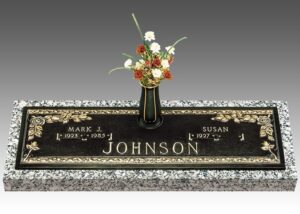Serving Many Cultural Purposes
While graves markers of days past were created of a variety of different materials, the most popular option now are bronze and granite grave markers. The memorial industry today specializes in both. While granite grave markers are still probably the most popular style, bronze grave markers are quickly proving to be an equally popular choice. Bronze grave markers, typically, include bronze plates with a special memorial design and letters that name the deceased as well as the dates of birth and death. These plates are then attached to a granite base and then installed in cemeteries to preserve the memory of a lost loved one. Granite grave markers, meanwhile, are formed from one of the world’s oldest and strongest natural materials, which has been shaped, polished and chiseled into a grave marker that will certainly last for ages
Grave markers serve a number of cultural purposes, the most of important of which, of course, is the preservation of a person’s memory for generations. Immedietly, however, they provide a permanent area of remembrance where family and friends can visit to remember and honor their dearly departed. In that way, grave markers also serve to help families cope with their losses. By having a grave marker always available to view in a specific location, families are practicing the sound advice that psychologists typically give to those going through the grieving process. Even people whose bodies have been cremated (a tradition whose popularity is increasing dramatically) can be memorialized with grave markers installed in cemeteries. There is even a cremation grave marker, which is made specifically to store the final remains of the individual, in a special compartment that is accessed through the bronze plaque. These memorials provide families with the option of a traditional burial ceremony.

But, besides their emotional value, grave markers are also important for historians. Grave markers assure that lives can be documented decades, or even centuries, after death. The sturdy construction of grave markers assures that the person being memorialized will be remembered long after the elements have destroyed paper records or technology has made electronic records obsolete.
For many years, grave markers were large, up-right pieces of sculpted stone that contained written information about the people whose graves they marked. While these “up-right” grave markers still are used today, they now usually mark groups of graves (such as an entire family). Up-right grave markers are less common today than they once were because time has shown that they have a tendency to deteriorate and fall over as years pass. Grave markers that are installed at ground level, meanwhile, tend to weather the elements much longer. These smaller grave markers are now the most common type. These plaque-like pieces are displayed directly on the ground at the head of a grave. And the grave markers typically memorialize one individual or a couple.
Grave markers can be purchased either “pre-need” or “at-need.” Pre-need grave markers are bought while a person is still alive. Many people choose the pre-need option because they want the peace of mind that comes from choosing the design and style of their own grave markers. Despite the advantages of pre-need buying, many family members buy grave markers for their loved-ones “at-need.” The decision of when to buy grave markers is deeply personal, and both methods are popular today.
